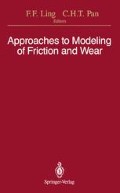Abstract
Surfactants and polymers added to boundary lubrication systems adsorb on solid surfaces and form a protective film. Effectiveness of boundary lubricants has often been attributed to the adsorption affinity and the integrity of the adsorbed film. Such adsorption is influenced by additives introduced into the system to reduce thermal degradation, corrosion, sludge formation, foaming etc. There are many interactions that can take place between the additives and the surfactants and the base oil leading in addition to adsorption effects, a number of interfacial and colloidal phenomena such as micellization, precipitation and solubilization as well as flocculation of particulate matter in the fluid [1]. Clearly the adsorption and integrity of the adsorbed film will depend on the molecular geometry of the interacting species. For example, among various saturated mono-, bi-, and tricyclic aromatics, alkanes, and polyethers tested as lubricating fluids by Hentschel [2], the “irregularly shaped molecules” yielded high traction coefficients whereas molecules with a “thread-like shape and minimum structural subunits or functional groups” yielded low coefficients. Evidently ability of molecules to undergo intramolecular as well as intermolecular motions is important in maintaining the integrity of the lubricating films.
Access this chapter
Tax calculation will be finalised at checkout
Purchases are for personal use only
Preview
Unable to display preview. Download preview PDF.
References
“Principles of Flocculation, Dispersion and Selective Flocculation,” P. Somasundaran, in Fine Particles Processing, P. Somasundaran, editor, 2, American Institute of Metallurgical Engineers, New York, 947–976 (1980)
“Precipitation Redissolution of Sulfonates and Their Role in Adsorption Minerals,” P. Somasundaran, M. S. Celik and A. Goyal, in Surface Phenomena in Enhanced Oil Recovery, D. O. Shah, editor, Plenum, New York, 641–647 (1981)
“Surfonate Precipitation-Redissolution-Reprecipitation in Inorganic Electrolytes,” M. S. Celik, E. D. Manev and P. Somasundaran, American Institute of Chemical Engineers Symposium Series, 78, 86–96 (1982)
R. Nagarajan, Personal Communications.
“The Influence of Molecular Structure on the Frictional Behavior of Lubricating Fluids,” K. H. Hentschel, Journal of Synthetic Lubrication, 2, 143–165 (1985)
“Tribology, Lubricants, and Lubrication Engineering - A Review, ” W. J. Bartz, WEAR, 49, 1 – 18 (1978)
“Effect of Additive Molecular Structure on Friction Coefficient and Adsorption,” S. Jahanmir and M. Beltzer, Journal of Tribology, 108, 109 – 116 (1986)
“Surfactant Adsorption at the Solid-Liquid Interface - Dependence of Mechanism on Chain Length,” P. Somasundaran, T. W. Healy and D. W. Fuerstenau, Journal of Physical Chemistry, 68, 3562 (1964)
“Adsorption of Ionic Surfactants,” D. B. Hough and H. M. Rendall, in Adsorption from Solution at the Solid-Liquid Interface, G. D. Parfitt and C. H. Rochester, editors, Academic Press, New York, 247–319 (1983)
“A Study of the Interactions Between Particles and Bubbles in Surfactant Solutions,” P. Somasundaran, P. Chandar and K. Chari, Colloids and Surfaces, 8, 121–136 (1983)
“Preparation and Characterization of Clean Mineral Surfaces,” P. Somasundaran and B. M. Moudgil, Surface Contamination, 1, K. L. Mittal, editor, 457 – 475 (1979)
“Fluorescence Probing of Microfluidity of Surfactant Layers at the Solid-Liquid Interface,” P. Somasundaran, N. J. Turro and P. Chandar, Colloids and Surfaces, 20, 145–150 (1986)
“Variation of Probe Chain Mobility in SDS Hemimicelles,” P. Chandar, P. Somasundaran, K. C. Waterman and N. J. Turro, Journal of Physical Chemistry, 91(1), (1987)
“The Direct Measurement of Normal and Retarded van der Waals Forces,” D. Tabor and R. H. S. Winterton, Proceedings of the Royal Society (London), A312, 435–450 (1969)
“Direct Measurement of Long Range Forces Between Two Mica Surfaces in Aqueous KNO3 Solutions,” J. N. Israelachvili and G. E. Adams, Nature, 262, 774–776 (1976)
Rights and permissions
Copyright information
© 1988 Springer-Verlag New York Inc.
About this paper
Cite this paper
Somasundaran, P. (1988). Role of Nanostructure of Adsorbed Layers in Lubrication. In: Approaches to Modeling of Friction and Wear. Springer, New York, NY. https://doi.org/10.1007/978-1-4612-3814-0_10
Download citation
DOI: https://doi.org/10.1007/978-1-4612-3814-0_10
Publisher Name: Springer, New York, NY
Print ISBN: 978-1-4612-8363-8
Online ISBN: 978-1-4612-3814-0
eBook Packages: Springer Book Archive

